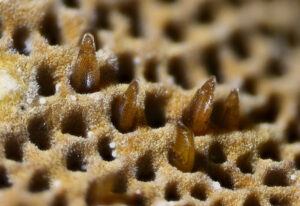Bracket fungus featherwing beetles

Bracket fungus
featherwing
beetles
In the book The Mushroom at the End of the World. On the Possibility of Life in Capitalist Ruins, in which the matsutake mushroom is a fine example of life understood as relations between species, the American anthropologist Anna Lowenhaupt Tsing emphasises the need for stories: “interspecies entanglements that once seemed the stuff of fables are now materials for serious discussion among biologists and ecologists, who show how life requires the interplay of many kinds of beings. […] The time has come for new ways of telling true stories […] such stories might be simultaneously true and fabulous.”[1] Listening attentively to things and telling their story can help to provide insights we need.[2]
Tsing recognises such an attitude in, among others, the artist John Cage. In the text Music Lovers’ Field Companion, Cage describes his ‘listening’: “I have come to the conclusion that much can be learned about music by devoting oneself to the mushroom. […] To begin with, I propose that it should be determined which sounds further the growth of which mushrooms; whether these latter, indeed, make sounds of their own; whether the gills of certain mushrooms are employed by appropriately small-winged insects for the production of pizzicati and the tubes of the Boleti by minute burrowing ones as wind instruments; whether the spores, which in size and shape are extraordinarily various, and in number countless, do not on dropping to the earth produce gamelan-like sonorities; and finally, whether all this enterprising activity which I suspect delicately exists, could not, through technological means, be brought, amplified and magnified, into our theatres with the net result of making our entertainments more interesting.”[3]